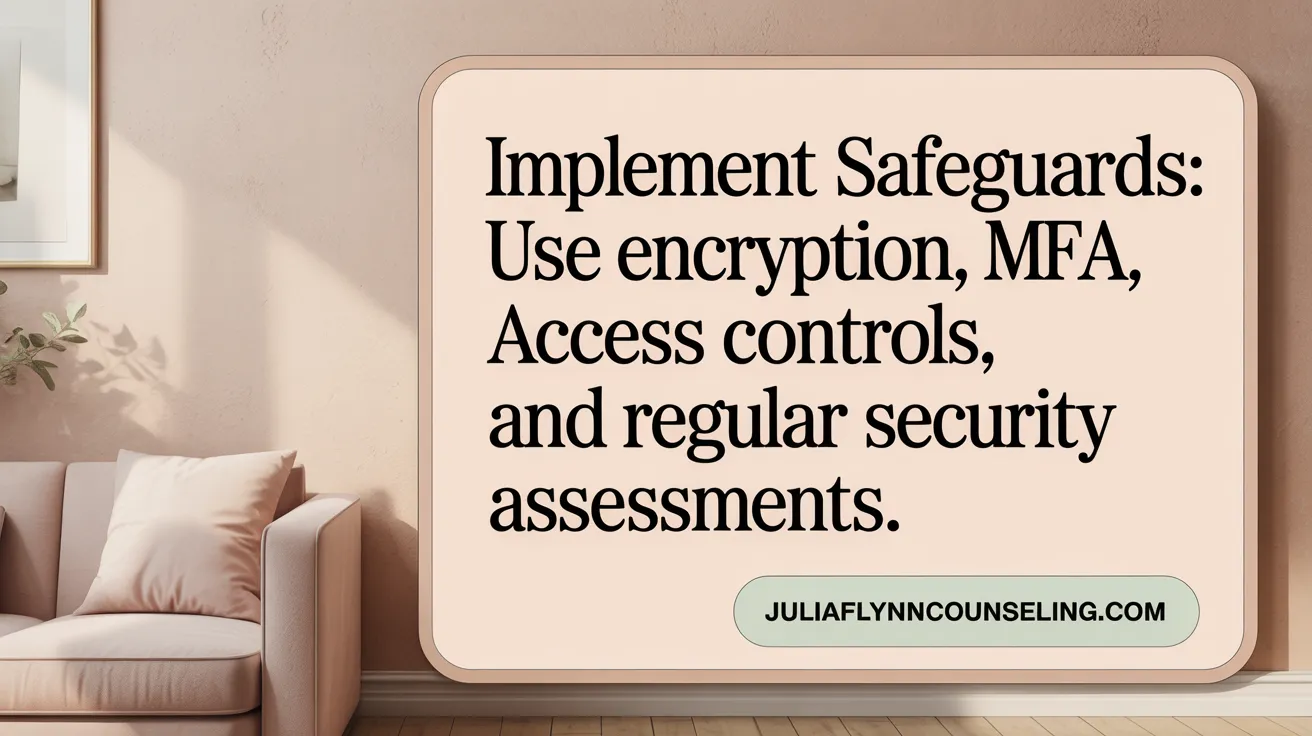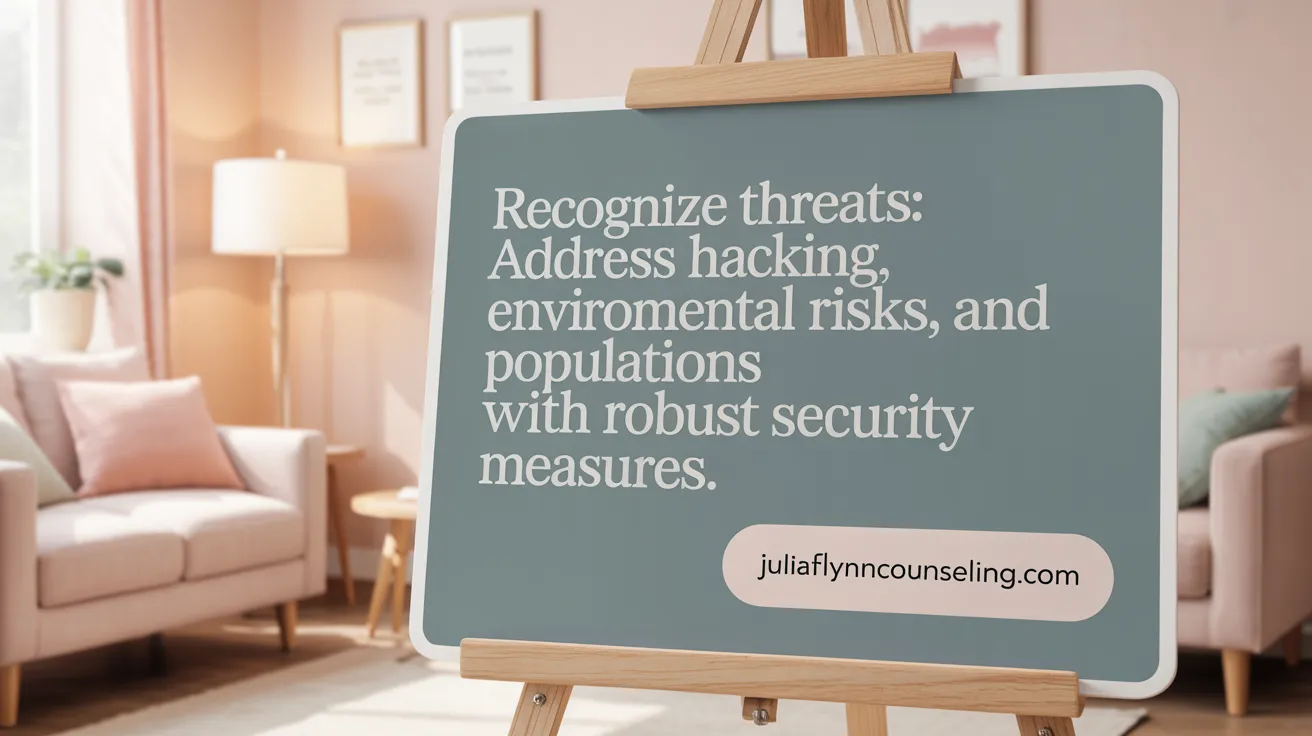Understanding Telehealth Privacy and Security
As telehealth counseling becomes an integral part of mental health services, ensuring the privacy and security of patient information is paramount. The digital nature of telehealth introduces unique challenges alongside its benefits of increased access and convenience. This article explores the measures, guidelines, challenges, and ethical considerations critical to safeguarding confidentiality in virtual counseling environments.
Maintaining Privacy and Security During Telehealth Counseling Sessions
 During telehealth counseling, protecting patient privacy and ensuring security are top priorities. These sessions are secured through encrypted communication channels, which convert sensitive data into a code that only authorized parties can decipher. Using platforms compliant with HIPAA and employing secure login procedures, such as multi-factor authentication, help prevent unauthorized access.
During telehealth counseling, protecting patient privacy and ensuring security are top priorities. These sessions are secured through encrypted communication channels, which convert sensitive data into a code that only authorized parties can decipher. Using platforms compliant with HIPAA and employing secure login procedures, such as multi-factor authentication, help prevent unauthorized access.
A critical step involves helping patients find private environments for their sessions. Providers should confirm that patients are in quiet, secluded spaces, and guide them to avoid public Wi-Fi networks, which pose risks of data interception. Strong, unique passwords and device security measures—such as regular software updates and antivirus protection—are vital in safeguarding devices and the transmission of health information.
Organizations implement comprehensive privacy protocols, including staff training on security best practices, verifying patient identities, and documenting all interactions carefully. Educating patients on maintaining their environment’s confidentiality—like using headphones, avoiding noise, and securing their internet connection—further enhances privacy.
Overall, a combination of technological safeguards, environmental control, and active patient participation ensures that telehealth counseling remains confidential and secure. This multidimensional approach helps build trust, complies with legal standards, and upholds the integrity of mental health services delivered virtually.
Best Practices and Guidelines for Protecting Patient Privacy in Telehealth
 In the rapidly expanding field of telehealth, safeguarding patient privacy and confidentiality remains a top priority. Best practices begin with selecting and utilizing HIPAA-compliant platforms that ensure secure communication channels. These platforms employ end-to-end encryption, safeguarding data during transmission and storage, which is vital for maintaining trust.
In the rapidly expanding field of telehealth, safeguarding patient privacy and confidentiality remains a top priority. Best practices begin with selecting and utilizing HIPAA-compliant platforms that ensure secure communication channels. These platforms employ end-to-end encryption, safeguarding data during transmission and storage, which is vital for maintaining trust.
Obtaining informed consent before each session is essential. Patients should be clearly informed about how their data will be used, the technology involved, and any potential privacy risks. Verifying patient identity at the outset of each session helps prevent unauthorized access and ensures that the individual receiving care is indeed the patient.
Creating private environments for telehealth consultations significantly reduces the risk of privacy breaches. Providers should conduct sessions in quiet, secluded settings free from interruptions or overhearing. Patients can also contribute by finding quiet spaces, turning off nearby electronic devices that might overhear conversations, and using headphones to enhance confidentiality.
Strong passwords and multi-factor authentication are critical in securing access to telehealth accounts. Both providers and patients should use unique, complex passwords and enable multi-factor authentication to add an extra layer of security. Regular software updates and security patches further protect against vulnerabilities.
Education plays a crucial role in privacy protection. Patients should be informed about cybersecurity threats such as phishing scams and advised on best practices for maintaining their privacy—like avoiding public Wi-Fi networks and unsecured networks for accessing telehealth services.
Healthcare organizations should establish comprehensive policies that encompass staff training, regular security assessments, and procedures for responding to potential privacy breaches. These proactive measures help create a culture of security awareness and ensure ongoing protection of sensitive health information.
By adhering to these guidelines—using secure platforms, obtaining informed consent, verifying identities, ensuring private settings, strengthening account security, and educating all users—telehealth providers can deliver effective care while minimizing privacy risks. Continuous diligence and updated practices are necessary to adapt to evolving cyber threats and protect patient trust in digital healthcare services.
Legal and Regulatory Framework Governing Telehealth Privacy and Security

What legal and regulatory requirements govern privacy and security in telehealth services?
Telehealth services operate within a complex framework of laws and regulations designed to protect patient privacy and ensure data security. The cornerstone of these requirements is the Health Insurance Portability and Accountability Act (HIPAA), enacted in 1996, which mandates that healthcare providers and covered entities use secure communication platforms, safe data storage, and implement safeguards such as access controls, encryption, and audit trails. These measures help prevent unauthorized access and data breaches during the electronic transmission of Protected Health Information (PHI).
Beyond HIPAA, many states have enacted their own privacy laws that extend or reinforce protections. These state-specific laws often include stricter rules on data sharing, patient rights, and confidentiality, especially for sensitive areas like mental health and substance use records. For example, 42 CFR part 2 offers additional confidentiality protections for substance use disorder treatment records, requiring explicit patient consent before disclosures are made.
The Federal Trade Commission (FTC) plays a vital role by enforcing laws related to consumer protection, data security, and breach notification. The FTC's oversight aims to prevent deceptive practices and penalize violations that compromise patient data.
Lawmakers also emphasize the importance of licensing and professional standards. Healthcare providers must verify licensure in the patient's jurisdiction and adhere to the relevant scope of practice and ethical guidelines during telehealth encounters (Licensure requirements and professional standards).
A crucial contractual requirement is the Business Associate Agreement (BAA), which vendors and third-party service providers must sign to ensure they comply with HIPAA's security rules. Compliance with such agreements ensures that all parties understand their responsibilities regarding data protection.
Finally, informed consent protocols are essential. Patients should be fully informed about how their data will be used, stored, and protected, and providers must obtain consent before initiating telehealth services, especially when involving sensitive or vulnerable populations (Informed consent in telehealth).
In summary, telehealth privacy and security are governed by a layered set of regulations that include federal and state laws, confidentiality standards like 42 CFR part 2, FTC enforcement policies, licensing requirements, and contractual agreements such as BAAs. Adherence to these regulations is vital to maintaining patient trust and safeguarding health information.
More information can be found by searching for: 'legal and regulatory requirements for telehealth privacy'.
This comprehensive legal landscape ensures that telehealth remains a safe, confidential, and compliant mode of healthcare delivery, reflecting ongoing efforts to adapt privacy protections to a rapidly evolving digital environment.
Critical Data Protection Measures and Handling Practices in Telehealth Platforms
In the rapidly expanding field of telehealth, safeguarding patient data is more crucial than ever. Essential measures include implementing end-to-end encryption, which ensures that data remains secure during transmission and storage. This encryption transforms sensitive health information into a code that can only be deciphered by authorized users, preventing unauthorized interception.
Multi-factor authentication (MFA) is another vital practice, adding layers of security by requiring multiple forms of verification before granting access to health data. This can include passwords, biometric verification, or temporary codes sent to trusted devices, significantly reducing the risk of unauthorized entry.
Strict access controls are also necessary to restrict data access only to those with proper authorization. This involves setting permissions based on roles within healthcare organizations and monitoring access logs regularly. Complementing these controls, routine vulnerability assessments help identify potential security gaps, enabling proactive measures to address emerging threats.
Maintaining updated software and security systems, such as firewalls, intrusion detection devices, and anti-virus software, provides an additional line of defense against cyberattacks. Organizations should also develop detailed policies for verifying patient identities and obtaining informed consent, ensuring that all data handling complies with legal standards.
Staff and patient privacy training are essential to foster awareness about best practices and potential risks. Educating users on security protocols, recognizing phishing attempts, and handling sensitive information responsibly can significantly reduce human error vulnerabilities.
Adherence to federal and state laws, including HIPAA regulations, is fundamental to legal compliance and building patient trust. Regular security audits and risk assessments—combined with secure communication channels and device management—are indispensable components of a comprehensive data protection strategy.
In summary, combining technical safeguards with policies, training, and regulatory compliance forms a robust framework for protecting patient data in telehealth platforms, ensuring confidentiality, integrity, and trust in virtual care delivery.
Technological Safeguards and Security Protocols Protecting Telehealth Systems

What security protocols and technological safeguards protect telehealth systems?
To thoroughly safeguard telehealth systems, healthcare providers need to employ a combination of strong security protocols and cutting-edge technology measures. End-to-end encryption is fundamental, ensuring that all data transmitted during telehealth sessions remains unreadable to unauthorized parties. Multi-factor authentication (MFA) adds an extra layer of security by requiring users to verify their identities through multiple methods, thus preventing unauthorized access.
Role-based access controls help restrict information to only those staff members who require it for their duties, minimizing the risk of data breaches. In addition, deploying firewalls and intrusion detection systems acts as a barrier against malicious cyber threats, alerting providers to suspicious activities promptly.
Secure cloud storage solutions, compliant with HIPAA and other standards, enable the safe storage of health records and session recordings, while regular software updates patch vulnerabilities and improve system resilience. Patient verification and informed consent procedures are vital, often involving identity checks and explicit permission before the start of any session.
Physical security measures, such as secure environments for conducting telehealth and managing devices with password protection and encryption, contribute to the overall security framework. Consistent staff training on privacy, cybersecurity best practices, and latest threat awareness ensures everyone involved understands their responsibilities.
Ongoing risk assessments, compliance with HIPAA, HITECH, and related regulations, along with patient education on safeguarding their devices and data, reinforce confidentiality, data integrity, and system availability. These combined efforts form a comprehensive shield protecting sensitive health information against evolving cyber threats.
Challenges, Risks, and Threat Models in Telehealth Privacy and Security

What are the main challenges, risks, and threat models related to privacy and security in telehealth?
Telehealth has revolutionized healthcare delivery by enabling remote consultations, but it also introduces a complex landscape of privacy and security challenges. One of the primary concerns involves cyber threats such as hacking, malware infections, phishing attacks, and data breaches. These malicious activities target sensitive patient information, risking unauthorized access, data theft, and manipulation of health records (Data Security in Telehealth, Telehealth Security Risks, Telemedicine Security Review).
Environmental privacy risks are significant, especially when patients lack private spaces during video or phone consultations. Patients living in shared or inadequate environments may inadvertently expose personal health details, compromising confidentiality (Telehealth Privacy Environmental Factors, Finding a Private Location for Telehealth). Vulnerable populations—such as the homeless, elderly, and adolescents—face amplified risks due to limited access to private spaces and low digital literacy, which hampers their ability to implement effective security measures (Privacy Challenges for Vulnerable Populations in Telehealth, Digital Literacy Issues in Telehealth).
Operational and reimbursement issues also pose challenges. Lack of staff training on cybersecurity best practices, inconsistent policies, and device maintenance problems can lead to vulnerabilities. For example, unpatched software or insecure devices can serve as entry points for cyber threats (Staff Training for Telehealth Privacy, Telehealth Security Best Practices).
Further complicating the landscape are regulatory gaps, particularly regarding consumer-facing telehealth apps and devices. Many of these tools lack comprehensive oversight and do not adhere to HIPAA-like standards, increasing the potential for data misuse, leaks, and non-compliance with confidentiality protections (Privacy Concerns with Online Therapy, HIPAA Limitations in Telehealth).
To effectively mitigate these risks, healthcare providers and organizations should adopt rigorous security practices. Implementing encryption for data at rest and in transit, employing multi-factor authentication, verifying patient environments before sessions, and regularly training staff on cybersecurity threats are critical (Improving Privacy and Security of Telehealth, HIPAA and Telehealth Privacy, Telehealth Privacy and Security Best Practices). Additionally, enhancing regulations to cover consumer apps and devices—alongside developing precise threat models—will strengthen protections, ensuring the privacy of patients' sensitive health information in the expanding telehealth ecosystem (Telehealth Privacy and Security Standards, Telehealth Policy and Privacy Guidance).
Ethical Considerations and Patient Empowerment in Telehealth Privacy
What ethical considerations surround patient confidentiality and privacy in virtual care?
In telehealth, safeguarding patient confidentiality involves implementing strong data security measures, such as end-to-end encryption, secure platforms, and encrypted communication channels. Clinicians must obtain clear informed consent from patients, explicitly explaining the potential risks, benefits, and limitations of virtual care technologies. It is their ethical duty to verify patient identity and ensure that communication occurs in private, secure settings to prevent unauthorized disclosures.
Addressing ethical issues also means recognizing and mitigating the digital divide. Unequal access to technology and varying levels of digital literacy can lead to disparities in care, which healthcare providers should actively work to reduce through policies, support systems, and education efforts.
Transparency plays a vital role, with clinicians explaining how data is used, stored, and shared. Adhering to legal standards like HIPAA and informing patients about privacy policies fosters trust and respects patient autonomy.
Balancing privacy with accessibility involves ensuring that security measures do not overly hinder access to care. For example, using user-friendly, secure platforms helps maintain confidentiality while ensuring that vulnerable and underserved populations are not excluded.
Supporting autonomous patient decision-making requires empowering individuals with knowledge about their rights, privacy risks, and how their data is managed. Providers should educate patients on privacy best practices, encouraging active participation and informed choices.
Overall, maintaining a balance between protecting sensitive information, promoting equitable access, and fostering open communication is essential. Upholding these ethical standards ensures that telehealth remains a trustworthy and patient-centered mode of care, aligning with professional responsibilities and standards.
Building Secure and Trustworthy Telehealth Counseling
Telehealth counseling presents transformative opportunities for accessible, flexible mental health care but simultaneously demands stringent privacy and security protections. By adhering to regulatory frameworks like HIPAA, employing robust technological safeguards, implementing comprehensive policies and staff training, and fostering patient education and ethical transparency, healthcare providers can uphold confidentiality and build patient trust. Overcoming the multifaceted challenges posed by technology vulnerabilities and environmental factors requires ongoing vigilance, innovation, and collaboration among stakeholders. Ultimately, prioritizing privacy and security is essential to realizing telehealth's full potential as a secure, confidential, and effective avenue for counseling in the digital age.
